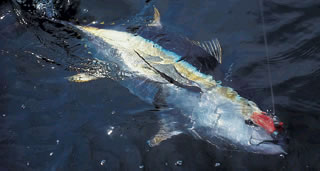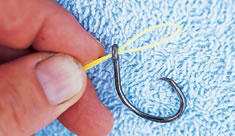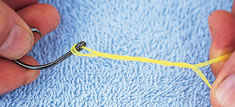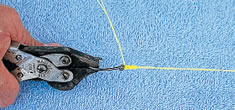
Captain Ray Rosher is an offshore- and bottom-fishing specialist who runs the 34-foot charter boat Miss Britt out of Monty's Marina in Coconut Grove, Florida. When it comes to catching sailfish, dolphin, swordfish, grouper and snapper for his clients, Rosher has an enviable record. It's no wonder he's booked well in advance during South Florida's peak fishing seasons.
One of Rosher's keys to success is preparation. He keeps his tackle in top shape and is meticulous about his knots, using only the strongest and most dependable connections to build his terminal-tackle systems. One of his mainstays is the tuna knot.
The tuna knot is basically an improved fisherman's knot. It's a strong knot that retains nearly 100-percent of the line's rated breaking strength. This is due in part to the double strands of line used to create the knot. Since there's no loss of line strength, the tuna knot is great for when you need to use lighter line to get more bites, and for putting the heat on big fish '’’ such as tuna.
However, don't let the knot's name mislead you into thinking that it's strictly for big game; it's also perfect for muscling big grouper, snapper and amberjack out of reefs and wrecks, as well as big snook, striped bass and even seatrout and redfish away from bridges, roots, rocks and docks. Since the tuna knot cinches down tightly to the hook eye, causing the hook to lay somewhat stiff, it's best used for fishing dead bait and chunks.
'I learned this knot from the late Captain Greg Beacher in 1982, while we were both studying for our captain's license in Miami,'� recalls Rosher. 'He and I had become pretty good friends during the early '�80s. I was getting ready to become the full-time captain on the Kelly Tractor-Caterpillar company boat, and Beacher was on the ground floor of the giant bluefin fishery in the Northeast when it was becoming very lucrative. He was catching and selling bluefins when prices were really skyrocketing.
'Beacher understood that using lighter leaders and circle hooks resulted in lip-hooked fish. When the bite was tough, he scaled down his leader or tied his hook directly to the fishing line and caught tuna when a lot of other captains didn't. Because these fish were hooked in the lip, there wasn't a problem with the lighter line abrading on the fish's teeth. And because he was using this knot, which didn't weaken the line, he could really pressure the fish. It wasn't something he needed every day, but when the fishing was tough he went lighter, used this knot with a circle hook, and caught fish. He swore me to secrecy on that knot, which I honored while he was alive. That knot made him a lot of money.
'I began using the knot after he showed it to me. Down here I even use it for dolphin when they become finicky. I'll drop to 30- and sometimes 20-pound-test leader just to get the bites. I don't use a circle hook when dolphin fishing, so I'll sometimes get a bit of chafing on the leader, which becomes the weakest link. But the knot holds. I'll use that knot on my swivels as well. For instance, I'll use it for attaching the main line and the leader to a swivel, and for securing the leader to the hook.
'I spent three hours one day on a knot machine, testing different knots against the tuna knot, including the uni and standard fisherman's knots. The tuna knot is by far the strongest.'�
As mentioned, the tuna knot does not allow the hook to swing on the leader, which could be a disadvantage when using live bait. However, the problem can be solved by bridling the bait. On the positive side, this rigidity could also result in more hook-ups by preventing the hook from swinging out of the way during a strike.
The other slight disadvantage of the tuna knot (which is really more of a cosmetics issue) is that the monofilament tends to wrinkle as the knot is cinched down. However, this can reduced by liberally lubricating the knot before tightening.
Tying the Tuna Knot
 |
1) Double approximately 18 inches of leader. |
 |
2) Pass half the loop through the hook eye. |
 |
3) With one hand, pinch the loop between two fingers and the standing and tag ends of the leader between another finger(s) and the palm of your hand. |
 |
4) With your other hand, rotate the hook three times, twisting the line up and away from the hook. |
 |
5) Rotate the hook three more times, this time twisting the line down and toward the hook. Take care not to let go of the loop. |
 |
6) Take the first loop and pass it through the smaller loop you've created at the eye of the hook. |
 |
7) Lubricate the line and tighten the knot by holding the standing and tag ends of the leader in one hand and pulling on the hook. Once the knot is seated, pull on the loop to remove the slight bulge at the base of the knot. |
 |
8) Trim the loop at the base of the knot, then trim the tag end. |
 |
9) The finished tuna knot. Note the double strands of line that have formed and reinforce this knot. |

